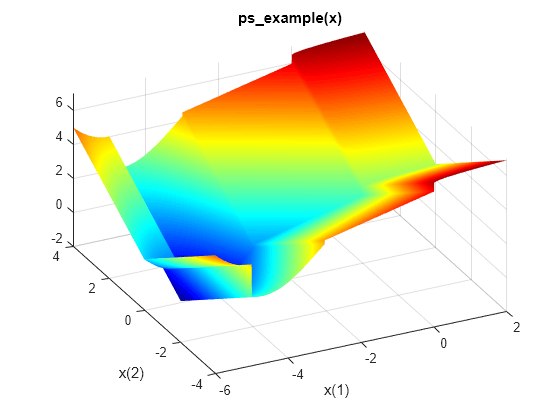Optimize Nonsmooth Function Using patternsearch, Problem-Based
This example shows how to minimize a nonsmooth function using direct search in the problem-based approach. The function to minimize, ps_example(x), is included when you run this example.
Plot the objective function.
fsurf(@(x,y)reshape(ps_example([x(:),y(:)]),size(x)),... [-6 2 -4 4],"LineStyle","none","MeshDensity",300) colormap 'jet' view(-26,43) xlabel("x(1)") ylabel("x(2)") title("ps\_example(x)")

Create a 2-D optimization variable x. The ps_example function expects the variable to be a row vector, so specify x as a 2-element row vector.
x = optimvar("x",1,2);To use ps_example as the objective function, convert the function to an optimization expression using fcn2optimexpr.
fun = fcn2optimexpr(@ps_example,x);
Create an optimization problem with objective function ps_example.
prob = optimproblem("Objective",fun);Specify the initial point x0 as a structure with field x taking the value [2.1 1.7].
x0.x = [2.1 1.7];
Solve the problem, specifying the patternsearch solver.
[sol,fval] = solve(prob,x0,"Solver","patternsearch")
Solving problem using patternsearch. patternsearch stopped because the mesh size was less than options.MeshTolerance.
sol = struct with fields:
x: [-4.7124 -7.6294e-07]
fval = -2.0000
patternsearch finds a better solution (lower function value) than the default fminunc solver, which is not recommended for minimizing nonsmooth functions.
[solfminunc,fvalfminunc] = solve(prob,x0)
Solving problem using fminunc. Local minimum possible. fminunc stopped because it cannot decrease the objective function along the current search direction. <stopping criteria details>
solfminunc = struct with fields:
x: [1.9240 8.8818e-16]
fvalfminunc = 2.9161
See Also
patternsearch | fcn2optimexpr | solve